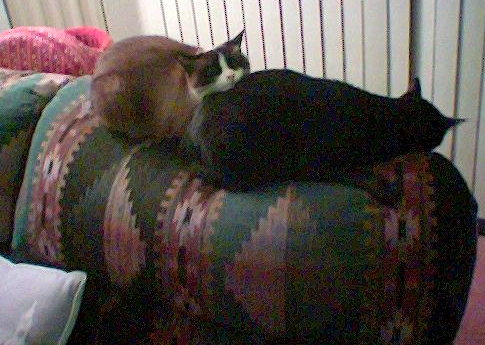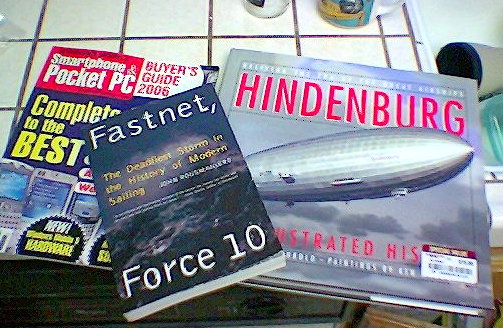;
Travels and Images
WEEK 8 2006
Last Week-
Sun- Mon- Tue- Wed- Thur- Fri- Sat- Next Week
Picture of the Week
MAIN PAGE
Saturday 25 February
2006
Saturday
- Book #11 is Shadow of the Giant,
by Orson Scott Card. It was a nice evening's read, and not a bad book,
but not particularly exciting.
Card, by the way, has a blog: The Ornery American. This week has a very interesting article about the United States and Iraq, "Iraq -- Quit or Stay", and it's well worth reading. Not that it'll change anyone's mind...
Victor Hanson has another essay on Iraq. Not that it'll change anyone's mind...
Are you a gadgeteer? Want to tinker with digital cameras, legos, gps, robotics, or bluetooth? Then MAKE is a site for you! Pretty cool stuff, actually.
More Olympic Curling news: streakers!.
Curlers probably feel a little safer than most athletes — it's hard for
intruders to run across ice, especially if they're naked.
Personally I'd leave my shoes on. Heh. Remember that song about streakers?
"I said, don't look Mabel, but it was too late..."
Some Headlines:
Curling History: 1st US Medal, 1st Streaker.
Streaker cuts no ice at curling match
With streaker, curling gets some extra exposure.
Apparently it was a well known streaker, advertising for some gambling web page. Professionalism has now even taken over the streakers in the Olympics!
Friday 24 February
2006
Friday - I was
thinking of visiting my Dad this weekend, but I wasn't feeling 100% and
he is just getting over a cold, so we agreed to put it off. No sense in going up just to
swap diseases. And, though it's been warm, there is supposedly a
storm arriving in the next couple of days.
So, spent some time today fooling about with the beowulf cluster at Dryden. Sigh. It's deja vu all over again...
Compiler issues, MPICH issues. No doubt solver issues, should I ever
get it working. I'm tempted to rebuild my cluster at home, just so I
can practice installing MPICH properly. I suspect a bad (or at least
incomplete) install is part of the problem.
I said I haven't followed the Olympics. I really haven't - I've no idea how many gold & silver & bronze medals "we've" won. But I did hear that we won a gold in curling. Curling? Is that the thing on ice with bombs from 'Help!'?
PDA pic:

It's not as innocent as it looks. Riley, to the left, is actually trying to nudge Phoebe off...
Some days are like that.
Thursday 23 February 2006
Thursday
- The Dirigible: wave of the future! [via Ghost of a Flea]
A question I've asked myself before: would I ride on a dirigible called 'Hindenburg'? Absolutely.
My friend Tim gave me a gift card, to thank me for PC help last year.
I'm embarrassed - he's always been the most helpful and generous man I
know with his own time and effort. Among a hundred other things: he replaced all the locks in my home when I bought it, he helped me rebuild both side fences more recently, once he even chopped up an old white elephant of a piano that I didn't know what to do with - the list goes on and on. So, I refused it took it down to Barnes & Noble and bought some cool stuff on Saturday:
 Thanks, Tim!
Thanks, Tim!
Book #10 is Fastnet, Force 10
by John Rousmaniere. This is about the infamous 1979 Fastnet disaster,
when a sudden summer storm devastated an offshore race involving over
300 boats. Rousmaniere himself was sailing in the race. He writes:
Of the
303 boats from 22 countries, 5 sank, 100 were rolled down so far they
put their masts in the water, and at least 75 were flipped down,
their mast (or what remained of them) aimed straight down, and their
rudders waving uselessly in the air.
He writes quite a bit about several different boats, and how different
boats experienced and reacted in different ways to the strange
unpredictable seas that were the primary menace. Larger boats like his
powered on through (as they later did in the infamous Sydney-Hobart
race) while smaller boats had to ride out the chop.
There are cautionary tales aplenty, about bad radios, bad safety
equipment, and so on. But in the end Rousmaniere comes down with the
Royal Offshore Racing Club investigation - it was just a terrible,
terrible, storm. The RORC put out a survey for all the participants to
answer, and Rousmaniere summarizes the results:
Answers
to various questions indicated that all four traditional storm tactics
- lying a-hull, running before it with warps dragging and without
dragging, and heaving-to - worked equally well. Three quarters of the
respondents said they would use the same tactics again. In the words of
the committee, "No magic formula for guaranteeing survival emerges from
those who were caught in the storm. There is, however, an inference
that active rather than passive tactics were successful and those who
were able to maintain some speed and directional control fared best."
Rousmaniere later wrote another book - Desirable and Undesirable Characteristics of Offshore Yachts - which goes a lot more into what technical lessons were learned from the race.
And, looking at Amazon, he has a number of other books. Some day I'll have to take a look....
Wednesday 22 February 2006
Wednesday
- I said the bug was fading, but it seems to have resurfaced. It was a
tired and achey day at work - just finishing some work on a proposal
(someone else's
proposal). I left work on time, or even slightly before - something
that I rarely do. So the cats have had more time to torment me as I try to
nap on the couch.
Book #9 is Wildtrack, by Bernard Cornwall.
Sort of an adventure/mystery, in the british fashion. It's revolves
around a wounded veteran of the Falkland's war, who after recuperating
discovers his beloved sailing boat has been damaged while he was in the
hospital. The novel spins a story of a clean cut war hero, noxious
English media personalities, sailing, evil American billionaires,
beautiful women, and murder.
Tuesday 21 February
2006
Tuesday - interesting clouds over the
valley this morning. They looked like giant white and grey jellyfish,
with streamers of rain hanging down like tentacles.
A lot of personnel in the branch are on travel - it is quiet at work, like the week before Christmas.
Monday 20 February 2006
Monday - the cold was just a 24 hour bug,
and is fading fast. I visited with some friends - helped a bit with
some PC problems - then went back home for a nice long nap and some
teevee. Not very exciting, but I wanted to review some stuff in the
evening.
I did that, paperwork on my lap desk, while watching House (tivoed).
Bought some groceries, forgot to put gas in the Explorer. Not 100%, obviously.
Sunday 19 February
2006
Sunday - snow on the mountains this
morning (see below), but none on the valley floor. A nice day, though I
am now battling a head cold.
An astronomer, M. Turnbull, recently came up with a list of Stellar Candidates for Habitable Worlds. Of course others have done this before. On my bookshelf is a book written more than 40 years ago: Planets for Man,
by Stephen Dole and Isaac Asimov, 1964. Comparing and contrasting their
likely solar system candidates we have just a few matches:
Dole & Asimov, 1964
|
Turnbull,2006
|
Alpha Centauri B
Epsilon Eridani
Tau Ceti
Alpha Centauri A
70 Ophiuchi A
Eta Cassipeiae A
Sigma Draconis
36 Ophiuchi A
36 Ophiuchi B
HR 7703 A
Delta Pavonis
82 Eridani
Beta Hydri
HR 8832 |
Alpha Centauri B
Epsilon Eridani
Tau Ceti
beta CVn
HD 10307
HD 211415
18 Sco
51 Pegasus
Omicron2 Eridani
Epsilon Indi A
|
Turnbull made a list of ten systems, five "most likely" to be good candidates for intelligent life (underlined in the table), and five that are good candidates to be seen
(with very advanced space telescopes). Indeed, since she looked at
17,000 systems and rated them, there are probably more systems in
common then I have listed.
Note that the Amazon.com link above for Planets for Man
is almost useless. The date is wrong, and it only lists Asimov as an
author. Dole had actually written a Rand Corporation report, Habitable Planets for Man,
and then he and Asimov paired up to write the Random House book later.
In Asimov's biography there's an amusing story about this. After the
book was written Dole asked that his name come first, despite the fact
that Asimov would normally be the lead author, since his name started
with A and he was better known. Dole explained that Asimov had lots of
books to his name (Asimov eventually wrote hundreds!) while he, Dole, might only have the one. Asimov laughed and agreed.
And while Dole does have a few other publications, they all seem to be rather dull Rand Corporation internal reports.
Amazon also has a separate link for Habitable Planets for Man, 1970.
It's unclear if it's a reprint of Dole's earlier Rand Corporation
study, a reprint of the 1964 book, or an updated and retitled version
of the 1964 book.
Wikipedia also has a list of the nearest bright stars.
Why bright stars in particular? Probably because there are a large
number of dim 'red dwarfs' that nobody really cares about, as
they are too small and cold to support life bearing planets, and of no
particular interest to astronomers and physics from a science
standpoint - they simple exist, glowing dimly, for billions and
billions of years, without exploding, flaring, collapsing into neutron
stars or black holes.





